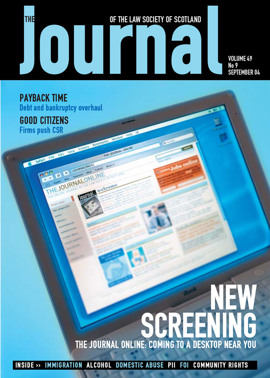Now it's collaborative
Collaborative family law is an exciting innovation which has swept the US and is gaining hold in England. The first four solicitors in Scotland have now completed the training: they are Gillian Crandles (Turcan Connell), Anne Dick (Mowat Hall Dick), Catherine Karlin (Anderson Strathern) and Shona Smith (Balfour & Manson).
Collaborative family law allows clients and legal advisers the opportunity of working together in a problem-solving way which maximises the options and minimises the friction. It fuses elements of information gathering and negotiation to make a structured process. It replaces an open-ended exchange of correspondence with a series of face-to-face meetings. The process recognises that separation is a transition experienced by a significant number of families and provides a structured setting which allows that transition to be as constructive as possible for all concerned. It accepts that the issues to be resolved are likely to generate negative emotional responses which need to be acknowledged but which should not form the basis for long-term decision making. It avoids inappropriate threats of litigation or withholding of relevant information derailing the negotiation process.
Stuart Webb, a family law practitioner in Minnesota, initiated the idea of collaborative law in 1989. It has proved to be “an effective way for lawyers to fall back in love with law practice” (Steven Keeva, ABA Journal, June 2003).
No deal – find another lawyer
The collaborative solicitors and the couple sign a formal contract at the outset, committing to work constructively to identify a mutually acceptable formula for settlement against a background of full disclosure. If an agreed outcome cannot be achieved then the two solicitors involved must both bow out. Neither of them can be involved in subsequent litigation for the couple. The experience in the countries where this is available has been that the approach generates a strong commitment to identify fair and workable solutions and produces good outcomes.The structure allows for a first individual client/solicitor consultation covering general legal information and an explanation about the process. This includes discussion about the likelihood that during this period of change and uncertainty a client will experience personal ups and downs, and the need for the client to make a commitment to letting the problem solving and decision making come from the up mode.
The two solicitors then meet to discuss how to set up the joint meeting as positively as possible. The objective is for the solicitors to manage the process and jointly provide information and advice about the law while encouraging the clients to participate fully and jointly in the solution seeking.
The first joint meeting allows the contract to be signed and arrangements are made about gathering in the relevant financial information. After the necessary details are available at the next four-way meeting, the two solicitors jointly describe their reading of the legal spectrum, then help the clients look at options. The pattern is for there to be individual client/solicitor meetings followed by a planning solicitor/solicitor meeting, then a joint meeting lasting no more than two hours, then a repeat of the cycle until a mutually acceptable formula is identified and set out in a written agreement.
Joint reference to experts
Another feature of the process is to have a joint reference to financial and other experts who may need to be involved. In complex cases the parties could meet individually and together with an accountant who understands the basis of the process, and the accountant could produce the summary of the necessary financial information.The approach formalises a way of dealing with family law close to how many family lawyers in Scotland try to work at the moment. It adds a structure which allows the best of the current practice to become a process rather than just a lucky mix of ingredients in isolated cases.
Mediators will recognise the powerful combination of interpersonal skills and legal information. Collaborative family lawyers retain the traditional role of legal adviser but in a joint problem-solving context. Mediation remains a uniquely powerful means for couples to take back control of planning their separate futures. Collaborative family law dramatically widens the opportunity for couples wishing direct separate legal advice throughout to benefit from a solution-seeking climate. It helps reinforce that family law can provide a creative response rather than a defensive reaction.
A quote from one of the pioneers of the movement, Pauline Tesler, helps sum up the flavour of the approach: “I say to them: if you would rather give up the right to dance at your daughter’s wedding for another $20,000 on the settlement, then there are lawyers down the street who would love to help you and you’ll send their child to university – not yours” (The Times, 4 November 2003).
Anne Hall Dick, Mowat Hall Dick, Glasgow
In this issue
- Profession's voice must be heard
- Let the cameras speak
- Vision on
- Forgive us our debts
- Written down
- DAS: the broader picture
- A lost message
- For the greater good
- Start your engines
- Are you covered?
- Opportunity knocks
- Rock bottom?
- BAILII looks for help
- On level ground
- Taking freedom seriously
- Taking out abuse
- Be ready for the options hearing
- Now it's collaborative
- Winning around a table
- Website reviews
- Scottish Solicitors' Discipline Tribunal
- Book reviews
- Beware all conveyancers!
- A-day looms closer






